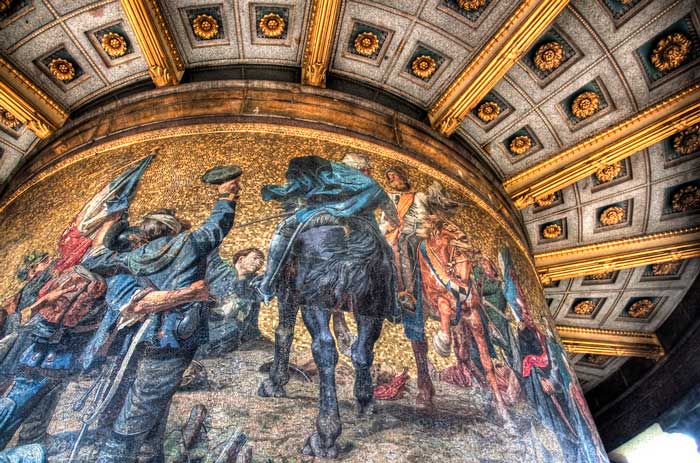
Located at the center of a roundabout on the main avenue of the Tiergarten, the tall Victory Column is one of the most iconic monuments to dot the landscape of Berlin. Initially, the soaring triumphal column was designed by Heinrich Strack in 1864 to commemorate the Prussian victory in the Second Schleswig War against Denmark. However, by the time it was inaugurated on 2 September 1873, by the Emperor Wilhelm I, Prussia had also defeated Austria and its German allies in the Austro-Prussian War in 1866 and France in the Franco-Prussian War during 1870-1871.In the wake of those military successes, known as the Wars of German Unification, the Kingdom of Prussia successfully united Germany as an imperial power under the Prussian crown.
However, the tremendous military and political success of the country elevated the purpose and deepened the definition of the triumphal tower and it was felt that erection of just a column is not sufficient to celebrate the purpose.

The Victory Column originally consisted of three sections, each of which represented a victorious war. In anticipation of his forthcoming victory in the World War II, another 7.5 meter section was added later to the height of the column by Hitler. This added portion increased the total height of the monument to 220 feet, which is almost 67 m.
The ornamented column stands on a hall of pillars decorated with a glass mosaic, designed by Anton von Werner. A wide four-sided base of polished red granite supports the circular colonnade from which rises the tall fluted column, crowned with a gilded statue. Three of the four pieces of the solid sandstone blocks, that comprises the Column, are decorated by cannon barrels captured from the enemies of the aforementioned three wars. A series of rings decorated with golden garlands leading to the top, was added later, in the mid-1930s.


The base of the Victory Column of Berlin is decorated with large bronze reliefs depicting few selected scenes from the wars. The colonnade above the base is decorated with a mosaic frieze created by Anton von Werner. It depicts the Liberation Wars and subsequent unification of Germany in 1871. The relief decoration was removed in 1945, only to be restored in 1987, by the French president at that time, Francois Mitterrand for the felicitation of the 750th anniversary of Berlin.


The top of the tall column is crowned with a bronze sculpture, which weighs 35 tons and measures 8 metres and 30 centimetres. It was added to the column after the Prussian victory over France. Created by Friedrich Drake, this figure represents Victoria, the goddess of victory, the Roman equivalent of the Greek goddess Nike. She is holding a laurel wreath in her raised right hand, while in the other hand, she has a spear, decorated with an iron cross and set in a wreath. As she has a helmet on her head, adorned with an eagle, the goddess may also represent ‘Borussia’, the Latin equivalent of Prussia. The locals affectionately call the statue ‘Goldelse’, the Golden Elsie. As the statue weighs over thirty tons, she is known as the 'heaviest woman in Berlin'.


The entire column, including the sculpture, is 220 feet (67m) tall. Just below the statue of gold, after 285 steps, there is a viewing platform from where one can appreciate the panoramic view of Berlin around the Tiergarten. Standing at the foot of the column, one can also admire the beautiful decorative bas-reliefs depicting war scenes. The circle of pillars at the base hosts instead a series of glass mosaics.
The victory column originally stood at the Königsplatz (now Platz der Republik), the square in front of the Reichstag, the historic edifice, which housed the Imperial Diet or the Parliament of Germany. The monument was shifted by the Nazi government to its present location in 1939, as a part of their major urban redevelopment plan, known as ‘Germania’ that would transform Berlin into the capital of the world. The relocation of the monument probably saved the monument from destruction, as its old site was destroyed by American air raids in 1945.